Maximization of the Production of a Low-Cost Biosurfactant for Application in the Treatment of Soils Contaminated with Hydrocarbons
Abstract
1. Introduction
2. Materials and Methods
2.1. Substrates Used to Produce the Biosurfactant
2.2. Microorganism and Inoculum Preparation
2.3. Influence of Substrates and Culture Conditions on Biosurfactant Production
2.4. Isolation of Biosurfactant
2.5. Determination of Biosurfactant Surface-Active Properties and Stability
2.6. Phytotoxicity Test
2.7. Chemical Composition of Biosurfactant
2.8. Kinetic Tests of Biosurfactant Removal of Exhaust Motor Oil Adsorbed to Sand and Soils
2.9. Static Test of Biosurfactant Removal of Exhaust Motor Oil Adsorbed to Sand and Soils in Packed Columns
2.10. Statistical Analysis
3. Results and Discussion
3.1. Influence of Nutrients and Culture Conditions on Biosurfactant Production
3.2. Determination of Critical Micelle Concentration
3.3. Emulsification Index
3.4. Stability of Biosurfactant under Different Environmental Conditions
3.5. Phytotoxicity Tests
3.6. Nuclear Magnetic Resonance (NMR) Spectroscopy
3.7. Fourier Transform Infrared (FTIR) Spectroscopy
3.8. Gas Chromatography–Mass Spectrometry (GC-MS)
3.9. Removal of Exhaust Motor Oil Adsorbed to Sand and Soils
4. Conclusions
Supplementary Materials
Author Contributions
Funding
Institutional Review Board Statement
Informed Consent Statement
Data Availability Statement
Acknowledgments
Conflicts of Interest
References
- Selva Filho, A.A.P.; Converti, A.; Soares da Silva, R.C.F.; Sarubbo, L.A. Biosurfactants as multifunctional remediation agents of environmental pollutants generated by the petroleum industry. Energies 2023, 16, 1209. [Google Scholar] [CrossRef]
- Sharma, N.; Lavania, M.; Lal, B. Biosurfactant: An emerging tool for the petroleum industries. Front. Microbiol. 2023, 14, 1254557. [Google Scholar] [CrossRef] [PubMed]
- Ahmed, S.; Kumari, K.; Singh, D. Different strategies and bio-removal mechanisms of petroleum hydrocarbons from contaminated sites. Arab Gulf J. Sci. Res. 2024, 42, 342–358. [Google Scholar] [CrossRef]
- Bi, H.; Mulligan, C.N.; Zhang, B.; Biagi, M.; An, A.; Yang, X.; Lyu, L.; Chen, X. A review on recent development in the use of surface washing agents for shoreline cleanup after oil spills. Ocean Coast. Manag. 2023, 245, 106877, ISSN 0964-5691. [Google Scholar] [CrossRef]
- Muñoz, E.E.; Farré, A.; Sánchez, A.; Font, X.; Gea, T. Microbial biosurfactants: A review of recent environmental applications. Bioengineered 2022, 13, 12365–12391. [Google Scholar] [CrossRef]
- Shakeri, F.; Babavalian, H.; Amoozegar, M.A.; Ahmadzadeh, Z.; Zuhuriyanizadi, S.; Afsharian, M.P. Production and Application of Biosurfactants in Biotechnology. Biointerface Res. Appl. Chem. 2021, 11, 10446–10460. [Google Scholar] [CrossRef]
- Rebello, S.; Asok, A.K.; Mundayoor, S.; Jisha, M.S. Surfactants: Toxicity, remediation and green surfactants. Environ. Chem. Lett. 2014, 12, 12275–12287. [Google Scholar] [CrossRef]
- Kalvandi, S.; Garousin, H.; Pourbabaee, A.A.; Farahbakhsh, M. The release of petroleum hydrocarbons from a saline-sodic soil by the new biosurfactant-producing strain of Bacillus sp. Biochem. Sci. Rep. 2022, 12, 19770. [Google Scholar] [CrossRef]
- Olukunle, O.F.; Olowoyeye, B.R.; Fadipe, T.O. Biosurfactant producing bacteria associated with oil polluted soils of some auto mechanic workshops in Akure, Ondo State, (Southwest) Nigeria. Adv. Life Sci. 2023, 10, 356–361. [Google Scholar]
- Fenibo, E.O.; Ijoma, G.N.; Selvarajan, R.; Chikere, C.B. Microbial surfactants: The next generation multifunctional biomolecules for applications in the petroleum industry and its associated environmental remediation. Microorganisms 2019, 7, 581. [Google Scholar] [CrossRef]
- Sar, P.; Kundu, S.; Ghosh, A.; Saha, B. Natural surfactant mediated bioremediation approaches for contaminated soil. RSC Adv. 2023, 13, 30586–30605. [Google Scholar] [CrossRef] [PubMed]
- Płaza, G.; Achal, V. Biosurfactants: Eco-friendly and innovative biocides against biocorrosion. Int. J. Mol. Sci. 2020, 21, 2152. [Google Scholar] [CrossRef] [PubMed]
- Ravish, J.P.; Amit, A.P.; Manan, A.R.; Vidhi, P.; Amit, A.; Ajazuddin. Chapter 2—Optimization and characterization of various biosurfactant and application in food industries. In Applications of Next Generation Biosurfactants in the Food Sector; Inamuddin, Adetunji, C.O., Eds.; Academic Press: Cambridge, MA, USA, 2023. [Google Scholar] [CrossRef]
- Cooper, D.G.; Paddock, D.A. Torulopsis petrophilum and Surface Activity. Full J. Name 1983, 46, 1426–1429. [Google Scholar] [CrossRef] [PubMed]
- Balina, K.; Soloha, R.; Suleiko, A.; Dubencovs, K.; Liepins, J.; Dace, E. Prospective life cycle assessment of microbial sophorolipid fermentation. Fermentation 2023, 9, 839. [Google Scholar] [CrossRef]
- Bjerk, T.R.; Severino, P.; Jain, S.; Marques, C.; Silva, A.M.; Pashirova, T.; Souto, E.B. Biosurfactants: Properties and Applications in Drug Delivery, Biotechnology and Ecotoxicology. Bioengineering 2021, 8, 115. [Google Scholar] [CrossRef]
- Sundaram, T.; Govindarajan, R.K.; Vinayagam, S.; Krishnan, V.; Nagarajan, S.; Gnanasekaran, G.R.; Baek, K.-H.; Rajamani, S.S.K. Advancements in biosurfactant production using agroindustrial waste for industrial and environmental applications. Front. Microbiol. 2024, 15, 1357302. [Google Scholar] [CrossRef]
- Sarmad, A.Q.; Severina, P.C. Production of biosurfactants via bio-waste valorization: A comprehensive review of characteristics, challenges, and opportunities in bio-sector applications. J. Environ. Chem. Eng. 2023, 11, 111555, ISSN 2213-3437. [Google Scholar] [CrossRef]
- Sharma, N.; Lavania, M.; Lal, B. Biosurfactant: A next-generation tool for sustainable remediation of organic pollutants. Front. Microbiol. 2022, 12, 821531. [Google Scholar] [CrossRef]
- Jimoh, A.A.; Lin, J. Biosurfactant: A new frontier for greener technology and environmental Sustainability. Ecotoxicol. Environ. Saf. 2019, 184, 109607. [Google Scholar] [CrossRef]
- Sałek, K.; Euston, S.R. Sustainable microbial biosurfactants and bioemulsifiers for commercial exploitation. Process Biochem. 2019, 85, 143–155. [Google Scholar] [CrossRef]
- Satpute, S.K.; Płaza, G.A.; Banpurkar, A.G. biosurfactants’ production from renewable natural resources: Example of innovativeand smart technology in circular bioeconomy. Manag. Syst. Prod. Eng. 2017, 1, 46–54. [Google Scholar] [CrossRef]
- Li, C.; Johansson, M.; Buijsen, P.; Dijkstra, G.; Sablong, R.J.; Koning, C.E. Limonene-derived polycarbonates as biobased UV-curable (powder) coating resins. Prog. Org. Coat. 2021, 151, 106073. [Google Scholar] [CrossRef]
- Kartini, K.; Huda, M.B.; Hayati, Z.M.; Sastika, N.; Nawatila, R. Scaling up stirring-assisted extraction and transformation of roselle anthocyanins into dried powder using spray-drying and oven-drying. Appl. Food Res. 2023, 3, 100357. [Google Scholar] [CrossRef]
- Farias, C.B.B.; Soares da Silva, R.D.C.F.; Almeida, F.C.G.; Santos, V.A.; Sarubbo, L.A. Removal of heavy oil from contaminated surfaces with a detergent formulation containing biosurfactants produced by Pseudomonas spp. PeerJ 2021, 9, e12518. [Google Scholar] [CrossRef] [PubMed]
- Cooper, D.G.; Goldenberg, B.G. Surface-active agents from two Bacillus sp. Appl. Environ. Microbiol. 1987, 53, 224–229. [Google Scholar] [CrossRef] [PubMed]
- Paul, I.; Mandal, T.; Mandal, D.D. Assessment of bacterial biosurfactant production and application in Enhanced Oil Recovery (EOR)—A green approach. Environ. Technol. Innov. 2022, 28, 102733. [Google Scholar] [CrossRef]
- Tiquia, S.M.; Tam, N.F.Y.; Hodgkiss, I.J. Effects of composting on phytotocicity of spent pig-manure sawdust litter. Environ. Pollut. 1996, 93, 249–256. [Google Scholar] [CrossRef]
- Varjani, S.J.; Upasani, V.N. Carbon spectrum utilization by an indigenous strain of Pseudomonas aeruginosa NCIM 5514: Production, characterization and surface-active properties of biosurfactant. Bioresour. Technol. 2016, 221, 510–516. [Google Scholar] [CrossRef]
- Luna, J.M.; Sarubbo, L.; de Campos-Takaki, G.M. A new Biosurfactant produced by Candida glabrata UCP 1002: Characteristics of stability and application in Oil Recovery. Braz. Arch. Biol. Technol. 2009, 52, 785–793. [Google Scholar] [CrossRef]
- Robert, M.; Mercadé, M.E.; Bosch, M.P.; Parra, J.L.; Espiny, M.J.; Manresa, M.A.; Guinea, J. Effect of the carbon source on biosurfactant production by Pseudomonas aeruginosa 44T1. Biotechnol. Lett. 1989, 11, 871–874. [Google Scholar] [CrossRef]
- Dahrazma, B.; Mulligan, C.N. Investigation of the removal of heavy metals from sediments using rhamnolipid in a continuous flow configuration. Chemosphere 2007, 69, 705–711. [Google Scholar] [CrossRef] [PubMed]
- Banat, I.M.; Carboué, Q.; Saucedo-Castañeda, G.; Cázares-Marinero, J.J. Biosurfactants: The green generation of speciality chemicals and potential production using Solid-State fermentation (SSF) technology. Bioresour. Technol. 2021, 320, 124222. [Google Scholar] [CrossRef]
- Alyousif, N.A.; Al-Tamimi, W.H.; Al-Sahib, M.A.A. Evaluation of the effect of various nutritional and environmental factors on biosurfactant production by Staphylococcus epidermidis. Biodivers. J. Biol. Divers. 2022, 23, 3533–3538. [Google Scholar] [CrossRef]
- Shah, M.U.H.; Sivapragasam, M.; Moniruzzaman, M.; Talukder, M.M.R.; Yusup, S.B.; Goto, M. Production of sophorolipids by Starmerella bombicola yeast using new hydrophobic substrates. Biochem. Eng. J. 2017, 127, 60–67. [Google Scholar] [CrossRef]
- Maddikeri, G.L.; Gogate, P.R.; Pandit, A.B. Improved synthesis of sophorolipids from waste frying oil using fed batch approach in the presence of ultrasound. Chem. Eng. J. 2015, 263, 479–487. [Google Scholar] [CrossRef]
- Kim, J.-H.; Oh, Y.-R.; Hwang, J.; Jang, Y.-A.; Lee, S.S.; Hong, S.H.; Eom, G.T. Value-added conversion of biodiesel into the versatile biosurfactant sophorolipid using Starmerella bombicola. Clean. Eng. Technol. 2020, 1, 100027. [Google Scholar] [CrossRef]
- Rocha Junior, R.B.; Meira, H.M.; Almeida, D.G.; Rufino, R.D.; Luna, J.M.; Santos, V.A.; Sarubbo, L.A. Application of a low-cost biosurfactant in heavy metal remediation processes. Biodegradation 2019, 30, 215–233. [Google Scholar] [CrossRef]
- Alfian, A.R.; Watchaputi, K.; Sooklim, C.; Soontorngun, N. Production of new antimicrobial palm oil-derived sophorolipids by the yeast Starmerella riodocensis sp. nov. against Candida albicans hyphal and biofilm formation. Microb. Cell Fact. 2022, 21, 163. [Google Scholar] [CrossRef]
- Ashish; Debnath, M.D. Application of biosurfactant produced by an adaptive strain of C. tropicalis MTCC230 in microbial enhanced oil recovery (MEOR) and removal of motor oil from contaminated sand and water. J. Pet. Sci. Eng. 2018, 170, 40–48. [Google Scholar] [CrossRef]
- Souza, K.S.T.; Gudiña, E.J.; Schwan, R.F.; Rodrigues, L.R.; Dias, D.R.; Teixeira, J.A. Improvement of biosurfactant production by Wickerhamomyces anomalus CCMA 0358 and its potential application in bioremediation. J. Hazard. Mater. 2018, 346, 152–158. [Google Scholar] [CrossRef]
- Somoza-Coutiño, G.; Wong-Villarreal, A.; Blanco-Gonzáles, C.; Pérez-Sariñana, B.; Mora-Herrera, S.I.; Rivas-Caceres, R.R.; Portilla-López, N.; Lugo, J.; Vaca-Paulín, R.; Águila, P.; et al. A bacterial strain of Pseudomonas aeruginosa B0406 pathogen opportunistic, produce a biosurfactant with tolerance to changes of pH, salinity and temperature. Microb. Pathog. 2020, 139, 103869. [Google Scholar] [CrossRef] [PubMed]
- Pinto, M.I.S.; Ribeiro, B.G.; Guerra, J.M.C.; Rufino, R.D.; Sarubbo, L.A.; Santos, V.A.; Luna, J.M. Production in bioreactor, toxicity and stability of a low-cost biosurfactant. Chem. Eng. Trans. 2018, 64, 595–600. [Google Scholar] [CrossRef]
- Yarava, J.R.; Potnuru, L.R.; Pahari, B.; Tothadi, S.; Ramanathan, K.V. Supramolecular synthon Identification in azelaic acid—Isonicotinamide. J. Magn. Reson. Open 2022, 10–11, 100056. [Google Scholar] [CrossRef]
- Zdarta, A.; Smułek, W.; Trzcińska, A.; Cybulski, Z.; Kaczorek, E. Properties and potential application of efficient biosurfactant produced by Pseudomonas sp. KZ1 strain. J. Environ. Sci. Health. A 2019, 54, 110–117. [Google Scholar] [CrossRef] [PubMed]
- Pubchem. 6,6-Dimethoxy-octanoic Acid, National Center for Biotechnology Information; Bethesda: Rockville, MD, USA, 2021. Available online: https://pubchem.ncbi.nlm.nih.gov/compound/6_6-Dimethoxy-octanoic-acid (accessed on 19 February 2024).
- ECMDB. Azelaic Acid (ECMDB21399) (M2MDB001794); The Metabolomics Innovation Centre: Edmonton, AB, Canada, 2015; Available online: https://ecmdb.ca/compounds/M2MDB001794 (accessed on 20 February 2024).
- Anwar, M.; Wahyuningsih, T.D. Synthesis and characterization of dialkanolamides from castor oil (Ricinus communis) as nonionic surfactant. IOP Conf. Ser. Earth Environ. Sci. 2017, 110, 12037. [Google Scholar] [CrossRef]
- Yang, J.; Geng, Q.; Zhou, Y.; Wang, Y.; Li, Z.; Liu, Y. Otimization of experimental procedure for determining azelaic acid in cosmetics by gas chromatography derivatized through ethanol. ACS Omega 2022, 7, 15647–15656. [Google Scholar] [CrossRef]
- Durval, I.J.; Rufino, R.D.; Sarubbo, L.A. Biosurfactant as an environmental remediation agente: Toxicity, formulation, and application in the removal of petroderivate in sand and rock walls. Biointerface Res. Appl. Chem. 2022, 12, 34–48. [Google Scholar] [CrossRef]
- Sales da Silva, I.G.; Almeida, F.C.G.; Rocha e Silva, N.M.P.; Oliveira, J.T.R.; Converti, A.; Sarubbo, L.A. Application of green surfactants in the remediation of soils contaminated by hydrocarbons. Processes 2021, 9, 1666. [Google Scholar] [CrossRef]
- Kumari, N.; Mohan, C. Basics of clay minerals and their characteristics properties. In Clay and Clay Minerals; Nascimento, G., Ed.; IntechOpen: London, UK, 2021; Volume 24, pp. 1–29. [Google Scholar] [CrossRef]
- Pejon, O.J.; Zuquette, L.V.; Augusto Filho, O. Geologia e solos. In Engenharia Ambiental: Conceitos, Tecnologia e Gestão; Calijuri, M.C., Cunha, D.G.F., Eds.; Elsevier: Rio de Janeiro, Brazil, 2013; pp. 15–46. [Google Scholar]
- Santos, E.M.S.; Lira, I.R.A.S.; Meira, H.M.; Aguiar, J.S.; Rufino, R.D.; Almeida, D.G.; Casazza, A.A.; Converti, A.; Sarubbo, L.A.; Luna, J.M. Enhanced oil removal by a non-toxic biosurfactant formulation. Energies 2021, 14, 467. [Google Scholar] [CrossRef]
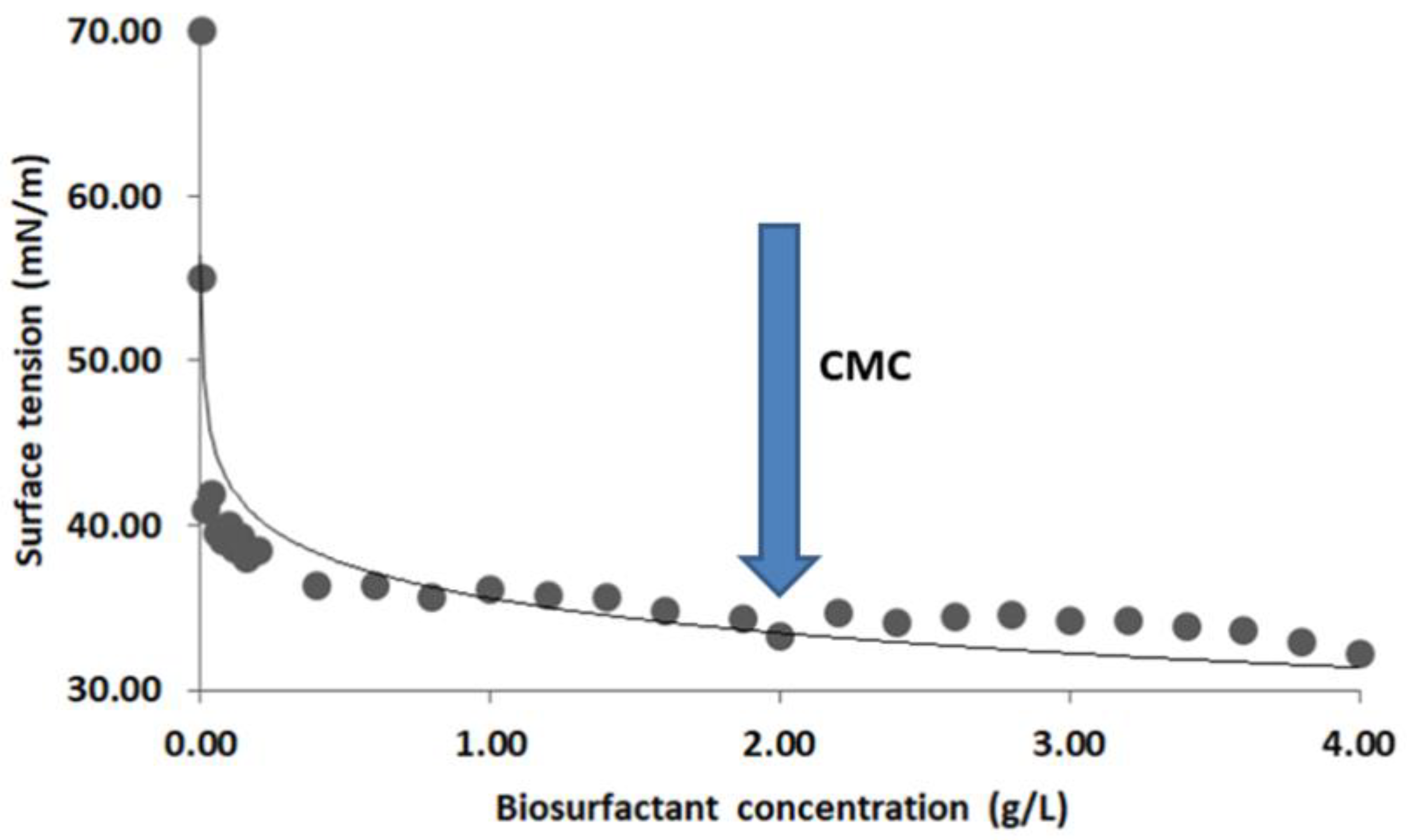
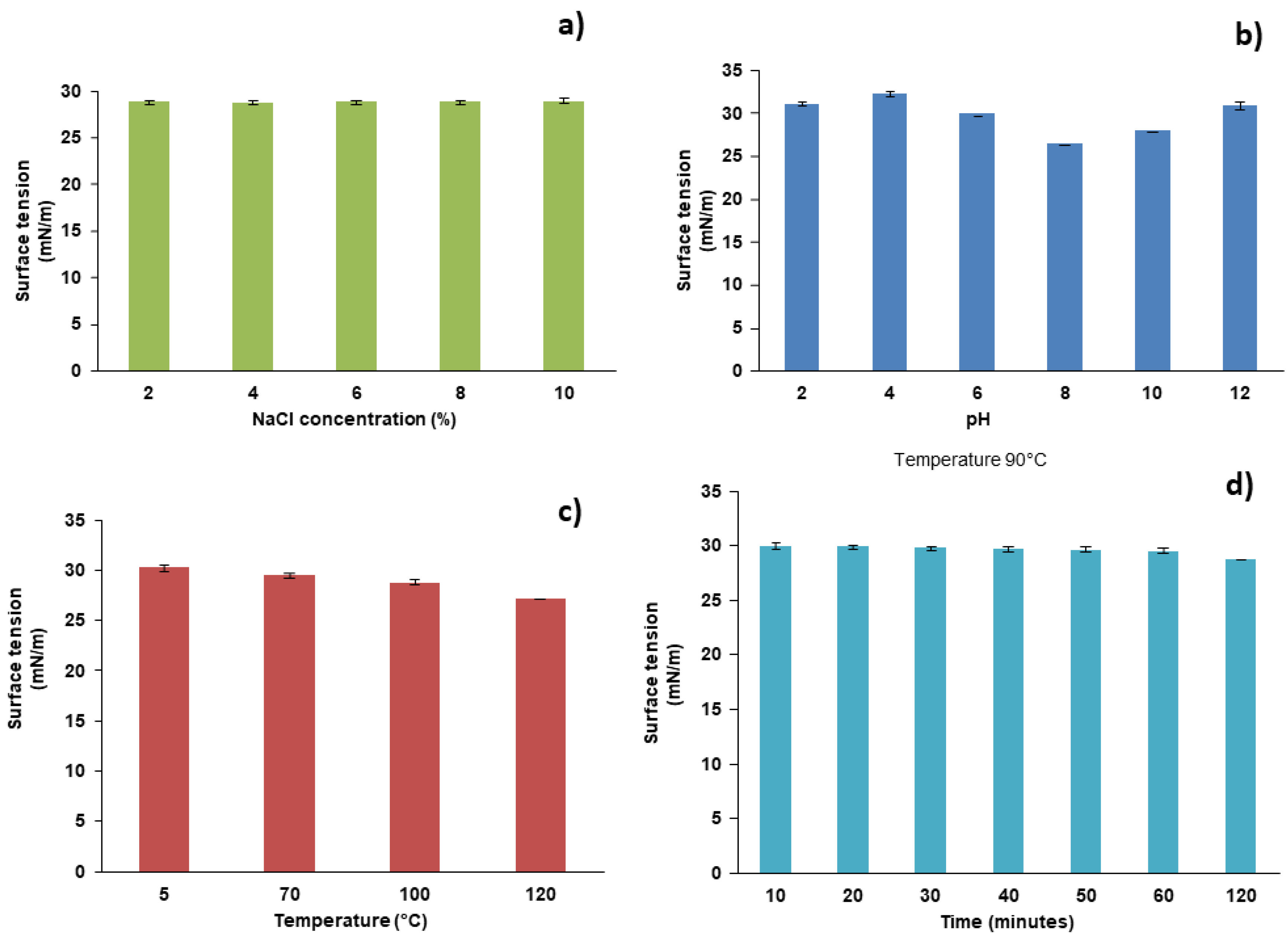
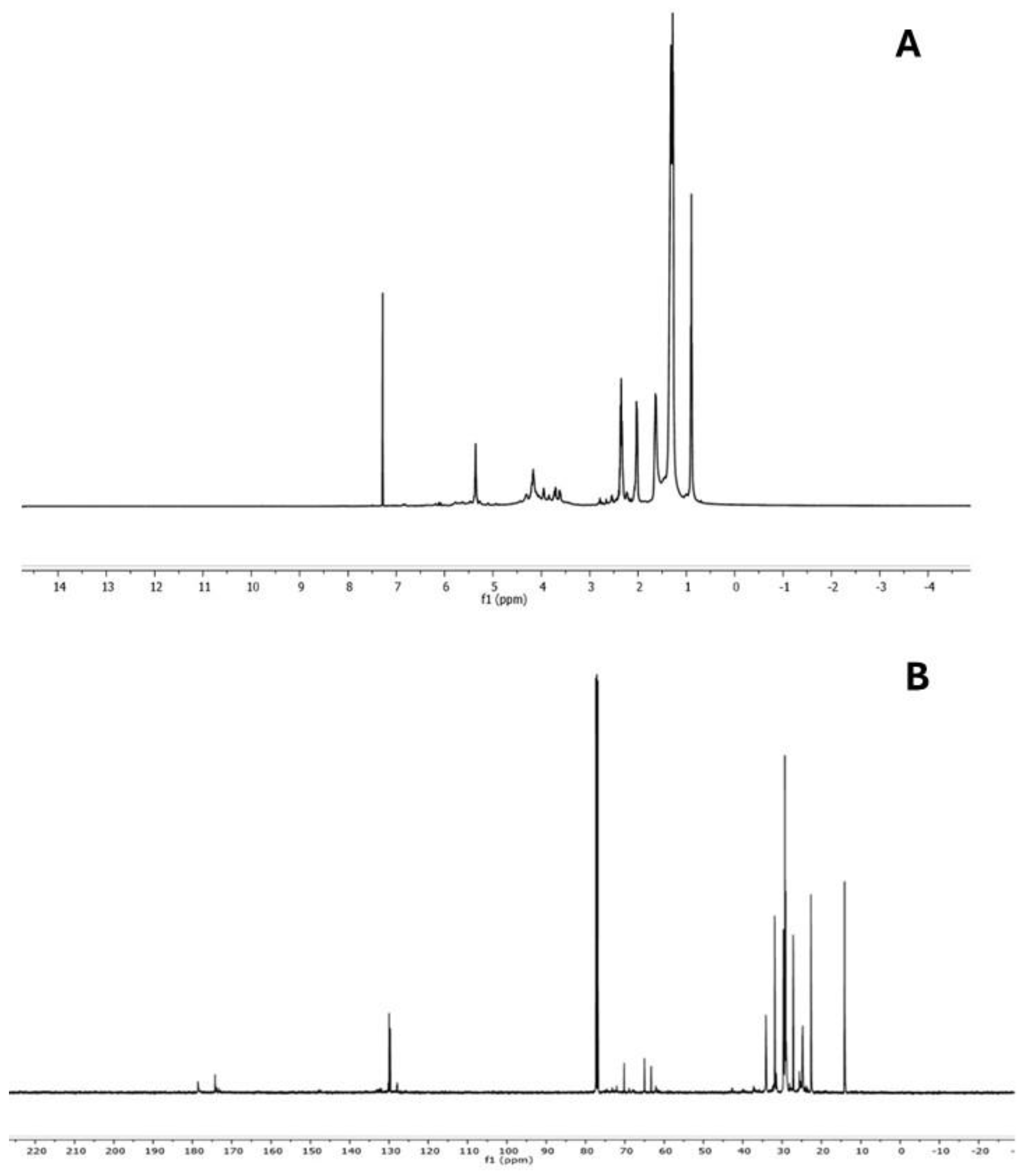
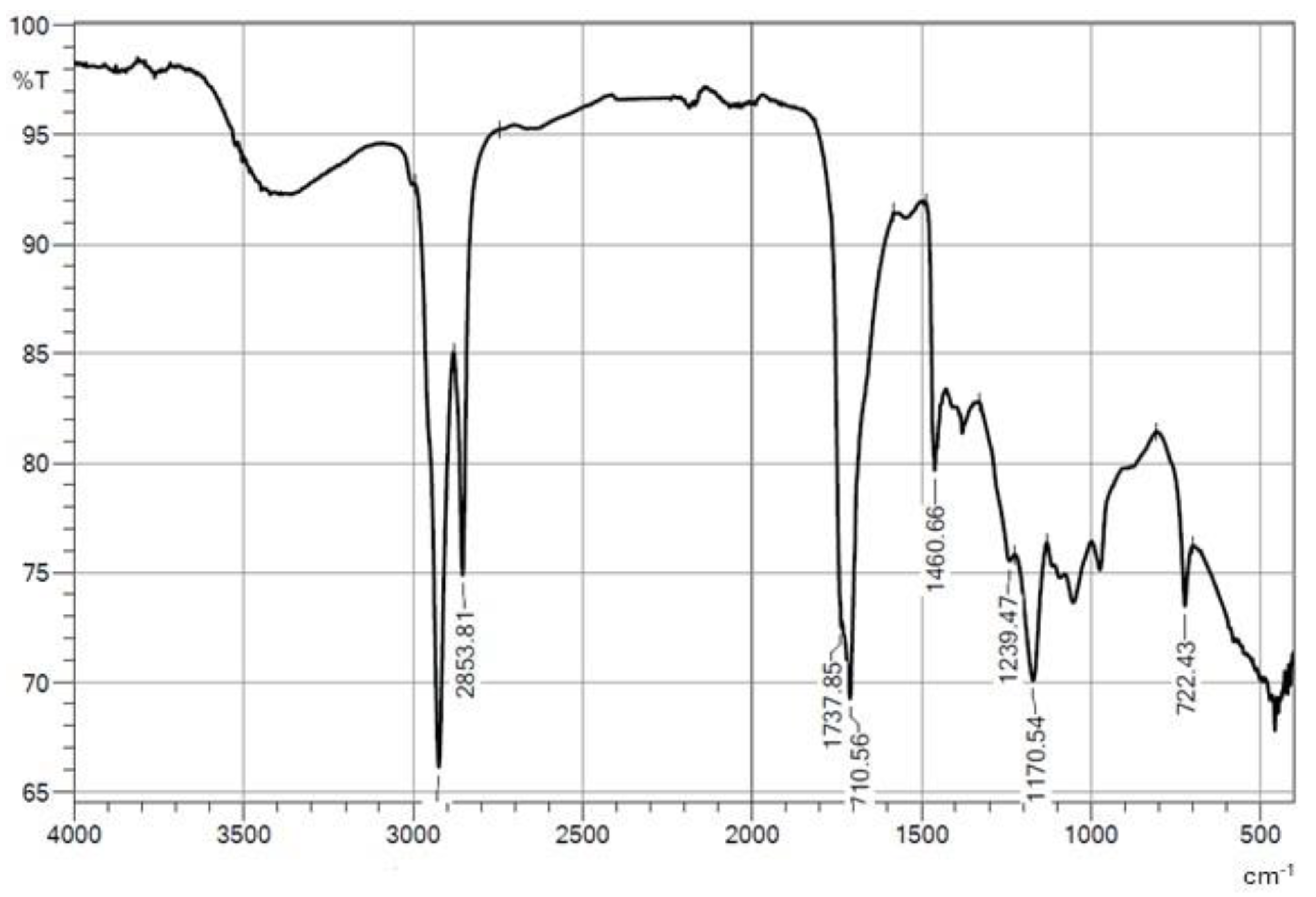
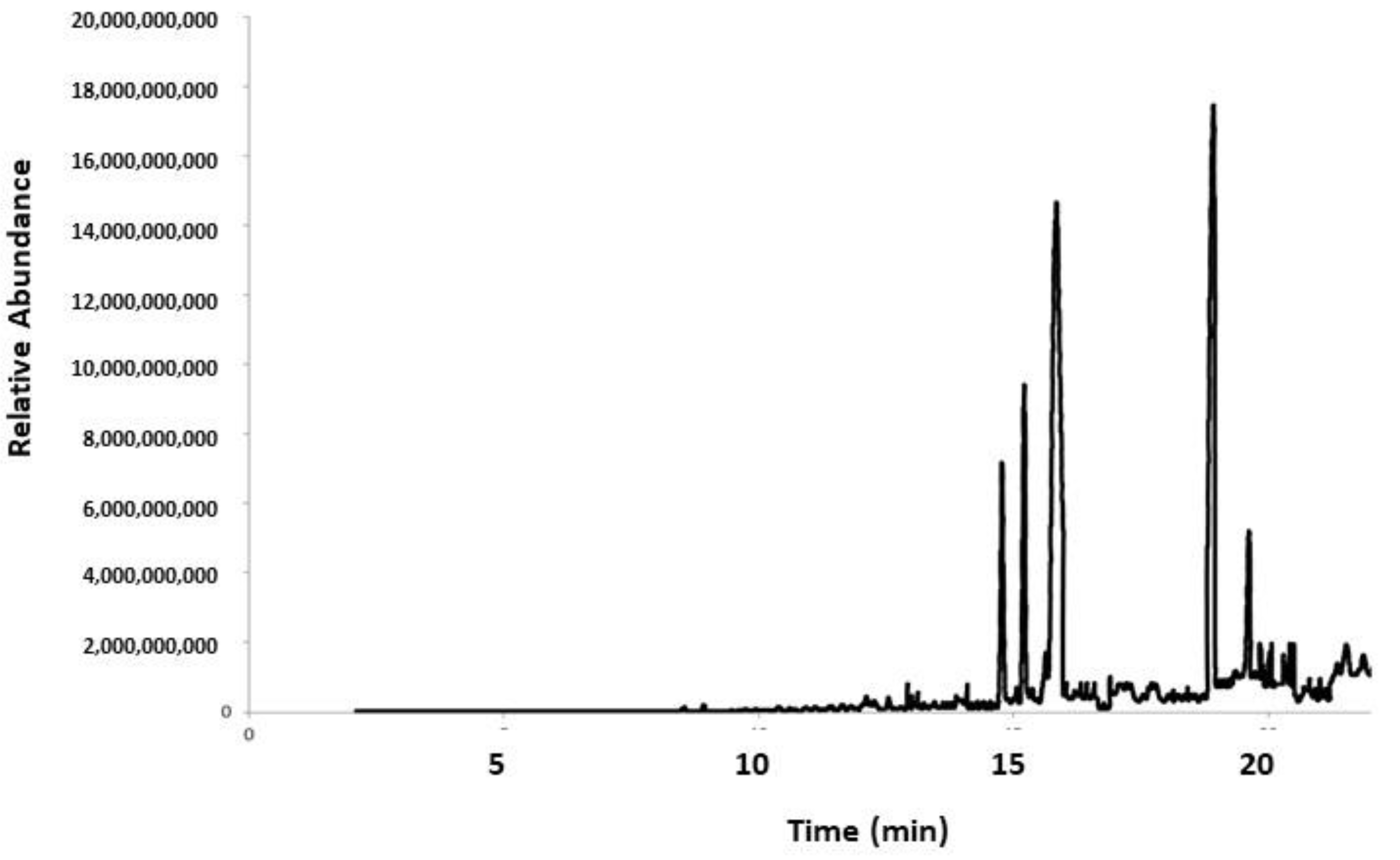
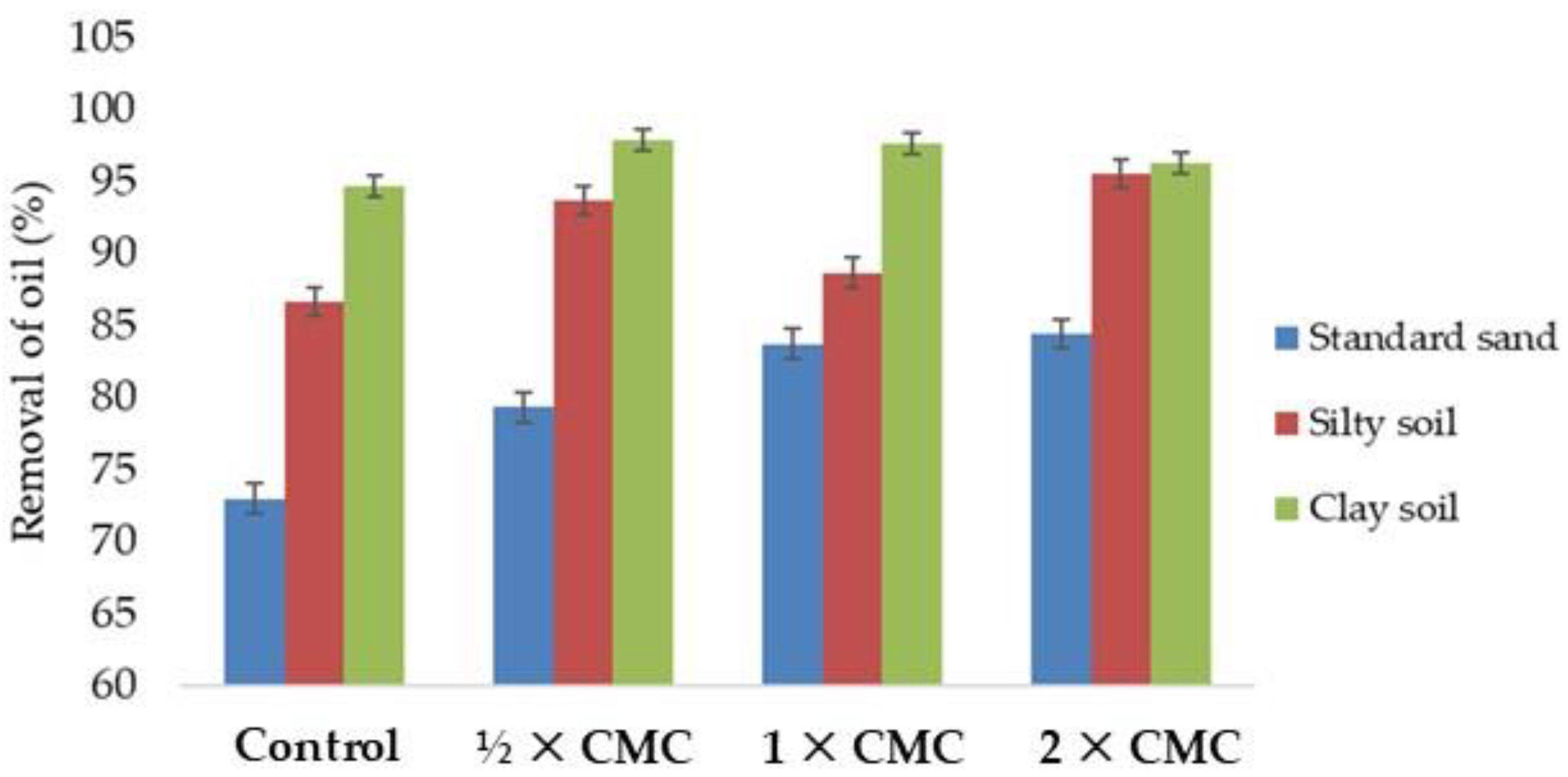
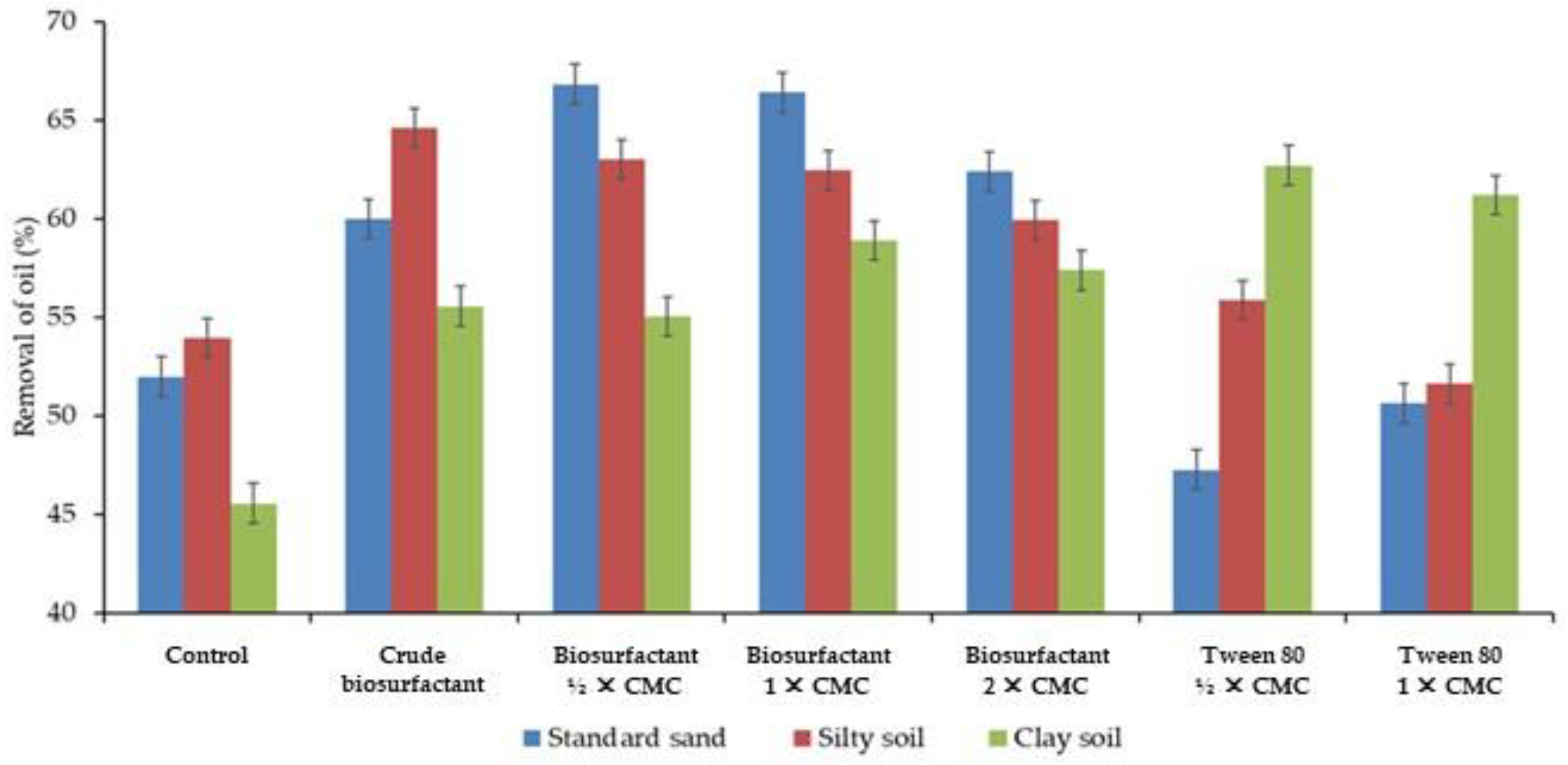
| (a) Selection of insoluble and soluble carbon sources at 5% concentration in the mineral medium (180 h at 200 rpm, 28 °C, and 5% inoculum) | |
| Insoluble Soybean frying oil Canola frying oil Cotton oil | Soluble Glucose Sucrose Sugarcane juice Sugarcane bagasse Molasses Irish potato peel flour Sweet potato peel flour |
| (b) Influence of the concentration of soluble carbon source selected (1.5%, 2.0%, 3.0%, 4.0%, and 5.0%) in the mineral medium (180 h at 200 rpm, 28 °C, and 5% inoculum) | |
| Irish potato peel flour | |
| (c) Influence of the concentration of the insoluble carbon source selected (1.5%, 2.0%, 3.0%, 4.0%, and 5.0%) in the mineral medium (180 h at 200 rpm, 28 °C, and 5% inoculum) | |
| Waste canola frying oil | |
| (d) Selection of nitrogen source in the mineral medium (180 h at 200 rpm, 28 °C, and 5% inoculum) | |
| Yeast extract (0.1%) Urea (0.1%) Corn steep liquor (3.0%) Corn steep liquor (3.0%) in deionized water | |
| (e) Influence of the concentration of nitrogen source selected (0.1%, 0.12%, 0.2%, 0.4%, and 0.6%) in the mineral medium (180 h at 200 rpm, 28 °C, and 5% inoculum) | |
| Urea | |
| (f) Influence of the shaking speed for the culture medium selected (180 h at 28 °C and 5% inoculum) | |
| 150, 180, 200, and 250 rpm | |
| (g) Influence of the shaking time for the culture medium selected (200 rpm at 28 °C and 5% inoculum) | |
| 96, 120, 150, and 180 h | |
| (h) Influence of the inoculum size for the culture medium selected (180 h, 200 rpm at 28 °C) | |
| 1.0%, 2.0%, 3.0%, 4.0%, and 5.0% | |
| (a) Insoluble carbon source | (a) Soluble carbon source | ||||||||
| Glucose | Sucrose | Sugarcane juice | Sugarcane bagasse | Molasses | Irish potato peel flour | Sweet potato peel flour | |||
| Soybean frying oil | 33.30 ± 0.03 | 32.90 ± 0.01 | 32.06 ± 0.04 | 32.06 ± 0.01 | 32.59 ± 0.03 | 32.02 ± 0.01 | 32.15 ± 0.01 | ||
| Canola frying oil | 32.87 ± 0.01 | 33.05 ± 0.02 | 32.05 ± 0.01 | 32.60 ± 0.02 | 32.77 ± 0.07 | 29.60 ± 0.01 | 31.19 ± 0.01 | ||
| Cotton oil | 32.87 ± 0.01 | 37.23 ± 0.03 | 37.81 ± 0.01 | 44.81 ± 0.03 | 39.91 ± 0.02 | 31.77 ± 0.06 | 30.05 ± 0.01 | ||
| (b) Irish potato peel flour concentration (%) | (e) Urea concentration (%) | ||||||||
| 1.5 | 2.0 | 3.0 | 4.0 | 5.0 | 0.10 | 0.12 | 0.20 | 0.40 | 0.60 |
| 31.84 ± 0.05 | 31.57 ± 0.06 | 31.60 ± 0.07 | 31.56 ± 0.08 | 31.50 ± 0.09 | 31.22 ± 0.05 | 32.28 ± 0.06 | 30.61 ± 0.07 | 38.60 ± 0.09 | 39.55 ± 0.08 |
| (c) Canola frying oil concentration (%) | (f) Shaking speed (rpm) | ||||||||
| 1.5 | 2.0 | 3.0 | 4.0 | 5.0 | 150 | 180 | 200 | 250 | |
| 33.45 ± 0.06 | 33.47 ± 0.07 | 33.68 ± 0.08 | 33.59 ± 0.09 | 31.57 ± 0.05 | 41.04 ± 0.09 | 40.41 ± 0.07 | 30.61 ± 0.06 | 41.50 ± 0.08 | |
| (d) Nitrogen source | (g) Shaking time (h) | ||||||||
| Yeast extract | Urea | Corn steep liquor in mineral medium | Corn steep liquor in deionized water | 96 | 120 | 150 | 180 | ||
| 32.56 ± 0.09 | 31.54 ± 0.08 | 32.66 ± 0.07 | 33.17 ± 0.08 | 33.23 ± 0.06 | 35.46 ± 0.08 | 35.27 ± 0.09 | 30.61 ± 0.07 | ||
| (h) Inoculum size (%) | |||||||||
| 1.0 | 2.0 | 3.0 | 4.0 | 5.0 | |||||
| 37.64 ± 0.07 | 34.12 ± 0.05 | 33.25 ± 0.06 | 31.16 ± 0.08 | 33.00 ± 0.09 | |||||
| Concentration of Biosurfactant | Brassica oleracea (Cabbage) | Solanum lycopersicum (Tomato) |
|---|---|---|
| ½ × CMC | 56.9 ± 0.7 | 79.3 ± 0.9 |
| 1 × CMC | 91.1 ± 0.7 | 34.3 ± 0.6 |
| 2 × CMC | 91.3 ± 0.8 | 29.5 ± 0.6 |
Disclaimer/Publisher’s Note: The statements, opinions and data contained in all publications are solely those of the individual author(s) and contributor(s) and not of MDPI and/or the editor(s). MDPI and/or the editor(s) disclaim responsibility for any injury to people or property resulting from any ideas, methods, instructions or products referred to in the content. |
© 2024 by the authors. Licensee MDPI, Basel, Switzerland. This article is an open access article distributed under the terms and conditions of the Creative Commons Attribution (CC BY) license (https://creativecommons.org/licenses/by/4.0/).
Share and Cite
Selva Filho, A.A.P.; Faccioli, Y.E.; Converti, A.; da Silva, R.d.C.F.S.; Sarubbo, L.A. Maximization of the Production of a Low-Cost Biosurfactant for Application in the Treatment of Soils Contaminated with Hydrocarbons. Sustainability 2024, 16, 7970. https://doi.org/10.3390/su16187970
Selva Filho AAP, Faccioli YE, Converti A, da Silva RdCFS, Sarubbo LA. Maximization of the Production of a Low-Cost Biosurfactant for Application in the Treatment of Soils Contaminated with Hydrocarbons. Sustainability. 2024; 16(18):7970. https://doi.org/10.3390/su16187970
Chicago/Turabian StyleSelva Filho, Alexandre Augusto P., Yslla Emanuelly Faccioli, Attilio Converti, Rita de Cássia F. Soares da Silva, and Leonie A. Sarubbo. 2024. "Maximization of the Production of a Low-Cost Biosurfactant for Application in the Treatment of Soils Contaminated with Hydrocarbons" Sustainability 16, no. 18: 7970. https://doi.org/10.3390/su16187970
APA StyleSelva Filho, A. A. P., Faccioli, Y. E., Converti, A., da Silva, R. d. C. F. S., & Sarubbo, L. A. (2024). Maximization of the Production of a Low-Cost Biosurfactant for Application in the Treatment of Soils Contaminated with Hydrocarbons. Sustainability, 16(18), 7970. https://doi.org/10.3390/su16187970









